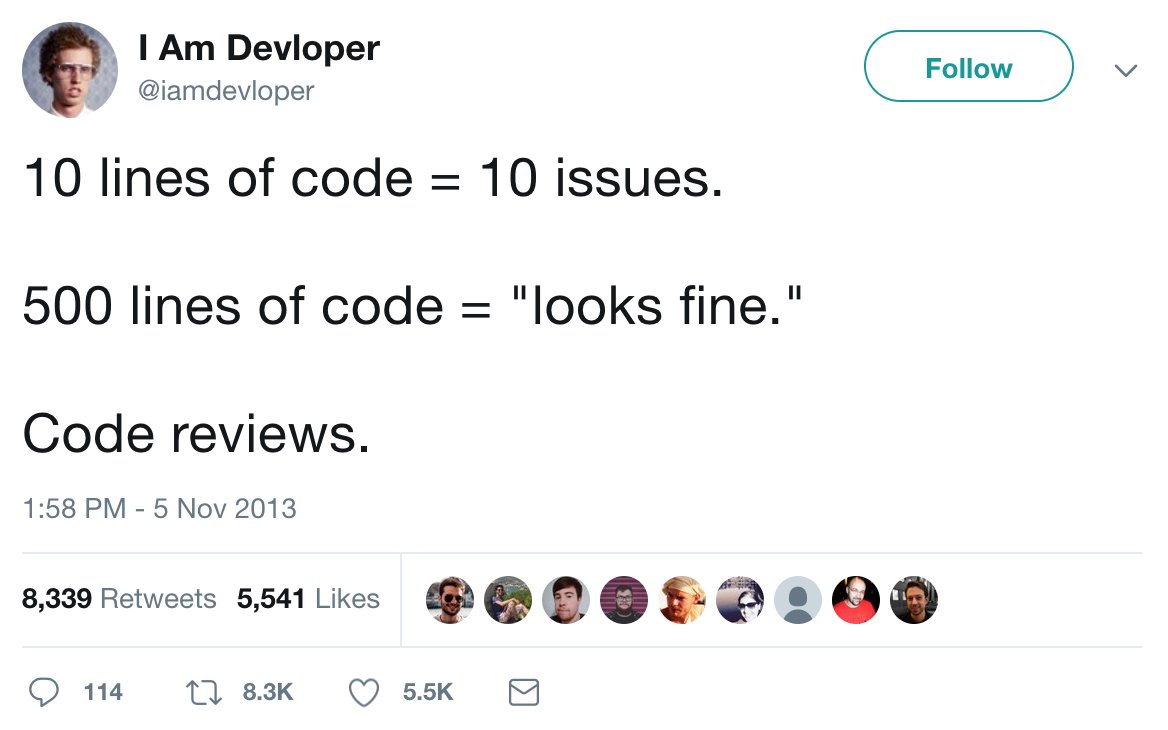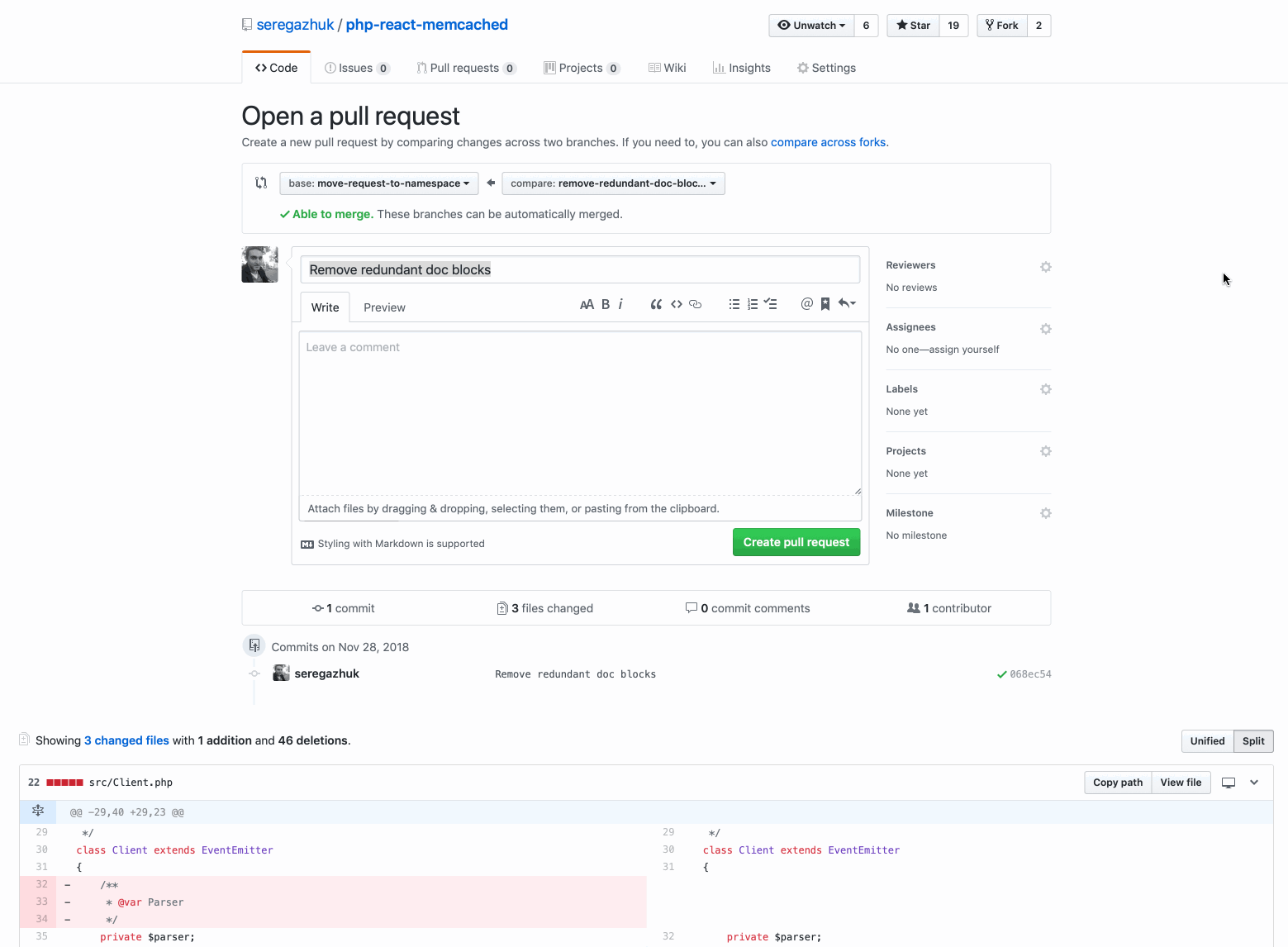How To Speed Up The Code Review
How does the code review process look? You submit a request, then receive feedback, make some fixes, push them, then receive approval and the request is being merged. Sounds nice, right? But sometimes the review process can become really painful.
Imagine that you have a pull request with hundreds lines of changes. The reviewer has to spend a lot of time to read all this code and understand suggested changes. As a result, the whole process from submitting a request to its approval can take several days. And it will be a pain for both the reviewer and the author of the request. And chances high that at the end of the day reviewer will still miss something. Also there may be another strategy when the request is reviewed superficially or in the worst scenario such a request can be immediately rejected.
So, the larger the request is the less valuable is its review.

How we can fix it? How we can make our pull-requests easier to review? So the review process becomes fast and valuable.
Categories of changes
Let’s imagine that you have a task, a new feature in the project. The pull-request you are working on may contain different categories of changes. Of course, you have some new code, that represents a feature itself. But, while working on it you may notice that some code should be refactored in order the feature to fit in. Or with this new feature, the code now contains a duplication and you want to extract it out. Or you have suddenly found a bug and want to fix. So, how should the final request look like?
First of all lets review what kinds of changes the code may have:
- Features - functional changes.
- Structure refactoring - changes in classes, interfaces, moving methods between classes.
- Simple refactoring - may be done by your IDE, e.g. extracting variables/methods/constants, simplifying conditionals).
- Renaming and moving classes - reorganizing namespaces.
- Removing unused (dead) code.
- Code style fixes - e.g. using autowiring, removing redundant doc-blocks.
- Formatting fixes.
Review strategies
It is very important to understand that each of these categories values differently and thus they. The reviewer should pay attention to different things when reviewing each of them. We may say that each category of changes has its own review strategy:
- Feature changes: fulfillment of business requirements and design.
- Structure refactoring: backward compatibility and design improvements.
- Simple refactoring: readability improvements. Because these changes are mostly may be done by IDE.
- Renaming/moving classes: whether the namespaces structure has become better.
- Removing unused code: backward compatibility.
- Code style fixes: in most cases instant merge.
- Formatting fixes in most cases instant merge.
Because different categories have different review strategies the time being spent on them also differs:
Feature changes. The longest one, because here we have changes in a domain logic. The reviewer decides whether the business problem is solved or not. The reviewer also checks whether the suggested solution is the best one or it can be improved.
Structure refactoring. Significantly shorter than feature changes. But here may be some suggestions and disagreements about the way the code should be organized.
All other categories in most cases are 99% instant merge:
- Simple refactoring. The code has become more readable? - merge.
- Renaming/moving classes. The class has been moved to a better namespace? - merge.
- Removing unused (dead) code - merge.
- Code style or formatting fixes - merge, people shouldn’t review them, it is the task for linters.
Why should we separate changes by categories?
We have already discussed that different categories of changes are valued differently. For example, in feature changes, we check business requirements, but in the structure refactoring, we review backward compatibility. And if we mix several categories it will be hard for a reviewer to keep in mind more than one review strategy. And most likely the reviewer will spend on the request more time than necessary and thus may miss something. Moreover, in a request that has mixed changes any fix being made will force the reviewer to review all these categories again. For example, someone mixes structure refactoring and business feature. Even if refactoring is done well, but there is an issue with a feature implementation, then after fixes, the reviewer has to review the whole request from the very beginning. That means that the reviewer has to look through both refactoring and the business feature from scratch. As a result, the reviewer has to spend extra time on the request. Instead of having a separate request with refactoring that could already have been merged the reviewer has to review the whole code one more time.
The worst category mixes
Class renaming/moving and its refactoring. Here we have to deal with Git which doesn’t correctly understand such changes. Here I’m talking about huge changes, where a lot of lines are being changed. When you refactor a class and then move it somewhere, Git will not detect a moving change. Instead, Git will interpret these changes as deletion of one class and a creation of another one. It leads to a bunch of questions on code review. The author is being asked why he or she had written this ugly code when in reality this code was just moved from one place to another with a bit of changes made inside.
Any feature + any refactoring. We have already discussed this mixin above. It forces the reviewer to keep in mind two review strategies. Even if the refactoring is done well, we can’t merge it until the feature is being approved.
Any machine-made changes + any human-made changes. Here, by “machine-made changes” I mean any formatting made by IDE or code generation. For example, we apply new code style and receive 3000 lines in a diff. And if we mix these changes with any feature or any other human-made changes, we will force the reviewer to mentally categorize these changes: whether it is a machine-made change and I should ignore it, or it is a human-made change and I should review it. As a result, extra time spent by a reviewer.
Example
Here I have a pull request with a feature of implementing a method that gracefully closes a Memcached client connection:

Even the request is small and contains just a hundred lines of code, it is still hard to review. As you can see by its commits it contains different categories of changes:
- feature (new code)
- refactoring (creation/moving classes)
- code style fixes (removing redundant doc blocks)
At the same moment, the feature itself is just 10 lines:

As a result, the reviewer has to look through all the code and:
- check that the refactoring is OK
- check that the feature was implemented correctly
- detect whether it was an automatic IDE change or a human-made one
So, it’s hard to review such a request. To fix it we can break these commits into separate branches and create pull requests for each of them.
1. Refactoring: extracting a class

Just two files here. The reviewer has to check just a new design. If everything is OK - merge.
2. The next step is also a refactoring, we just move two classes to a new namespace

This request is pretty simple to review and can be instantly merged.
3. Removing redundant doc blocks

Nothing interesting here. Instant merge.
4. The feature itself

And now the “feature” request contains only the “feature” code. So, the reviewer can concentrate only on it. The request is small and easy to review.
Conclusion
A rule of thumb is:
Don’t create huge pull-requests with mixed categories of changes.
The bigger the request is, the harder it is for reviewer to understand your suggested changes. It most likely that a huge request with hundreds lines of code will be rejected. Instead, break it down into small logic pieces. If your refactoring is OK, but the feature has bugs then the refactoring can already be merged. So, you and reviewer can concentrate on a feature instead of reviewing the whole code from the very beginning.
And always follow these steps before submitting a pull-request:
- Optimize your code for reading. The code is read much more often than it is written.
- Describe suggested changes in order to provide a context for diffs in the request.
- You should review your code by yourself before submitting the request. Review your own request as it is not yours. Sometimes you may find something you have missed. This will reduce the circles of rejecting/fixing.
The idea of splitting changes into categories was coined by my colleague Oleja Antonevich.